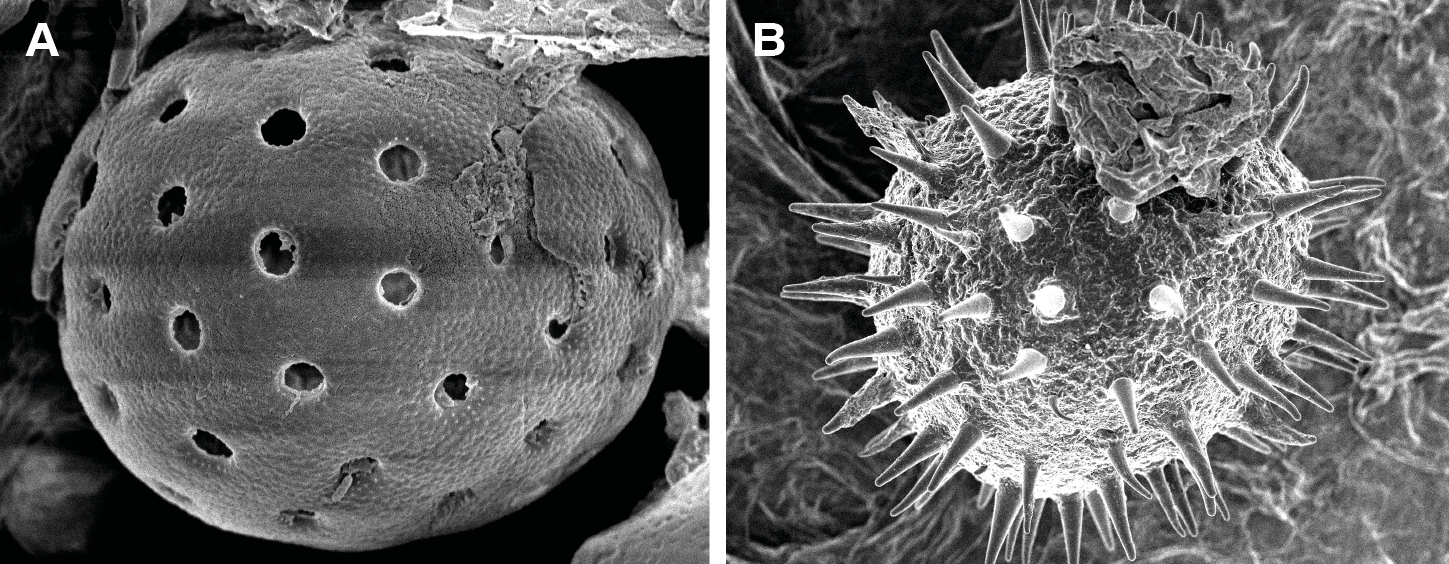- Home
- Publications
- PAGES Magazine
- The Palynology and Paleoenvironment of The Coastal Environment of Southern Nigeria In The Holocene
The palynology and paleoenvironment of the coastal environment of Southern Nigeria in the Holocene
Ajikah LB, Adekanmbi OH, Orijemie EA, Bamford M & Phiri E
Past Global Changes Magazine
30(2)
120
2022
Linus B. Ajikah1,2, O.H. Adekanmbi3, E.A. Orijemie4, M. Bamford1 and E. Phiri5
To study the upsurge of changes in vegetation around the coastal environment of Southern Nigeria (CESN) and assess the impacts of these changes, Dr. Linus Ajikah, from the University of Calabar, Nigeria, traveled to Stellenbosch University, South Africa, as a PAGES Inter-Africa Mobility Research Fellow. There he collected data on the distribution of palynomorphs using a scanning electron microscope (SEM), which were used to infer changes in vegetation characteristics of the CESN in the past.
The Holocene epoch, the latest interval of geologic time, covers approximately the last 11,700 years of Earth's history. It is an era of globally pervasive and steeply increasing anthropogenic influence on the Earth system. In West Africa and other parts of the tropics, the late Holocene (4500 yr BP–present) has been characterized by fluctuating environmental conditions, resulting in the fragmentation of rainforest ecosystems, the increase in secondary forests (Sowunmi 1981a, b), the decline in the freshwater and mangrove swamp forests vis-à-vis the emergence of coastal savannas (Orijemie and Sowunmi 2014), and the drastic fall in sea and lake levels (Tossou et al. 2008). These environmental changes have not only affected vegetation and hydrological systems but have also impacted human societies and cultural transformations that contributed to the collapse and emergence of complex societies and their food production systems (Kay et al. 2019). The swamps that make up the coastal environment of Southern Nigeria (CESN) have recorded severe loss of habitat and biodiversity. This loss causes damage to the ecosystem through time due to petroleum exploration, population increase, and associated anthropogenic activities in the area. These have often resulted in the loss of vegetation, extreme weather, and climatic conditions. There is limited concern for the implications of these changes on vegetation and climate amongst the local communities and government. This is due to poor knowledge of the changes in land cover around these coastal environments; also, very little is known about the changing chronological record of the land cover and climate of the CESN.
Thus, the aim of this study was to reconstruct the past vegetation of selected locations around the CESN and infer important climatic parameters during the Holocene. An important aspect of this research was to develop an atlas, or pollen library, of photo and SEM micrographs of palynomorphs to enable the accurate identification of materials recovered from other CESN sites.
Methods
Samples were collected at 10-cm intervals to a depth of 3 m, using a universal peat corer. Subsamples were then subjected to standard palynological, sedimentological, pH, and salinity analyses (Erdtman 1969; Faegri and Iversen 1989). For the SEM, samples were mounted onto standard 12-mm aluminum SEM stubs and sputter-coated with a thin layer of gold to enhance conductivity. Images were visualized and captured with a Zeiss Merlin field emission at the Central Analytical Facility, Stellenbosch University, South Africa.
Findings
A total of 42 palynomorph types were recovered. The pollen sum ranged from 158 to 1601, with 79 SEM pollen and spore photomicrographs captured (Fig. 1). Dominant palynomorphs included Symphonia globulifera, Cyclosorus spp, and Poaceae. Other palynomorphs were Alchornea sp, Aspilia africana, Nephrolepis bisserata, Polypodium spp, and fungal spores.
Three phases of environmental change were identified with the oldest phase (phase I, 1510–1480 yr BP) comprising a complex mixture of mangrove swamp forest, freshwater swamp forest, ferns, and open vegetation. The rainforest was present but reduced in area. Phase II was similar but with low mangrove and rainforest but with some more open vegetation taxa. This was most likely a result of the impact of human activities, and possibly some local dry conditions. In phase III, the environment became more open; the mangroves expanded, but the rainforest area remained low. Conditions became wetter; the area was likely exposed to flooding, and human activities increasingly interfered with the environment. For the last 1400 years, the rainforest has witnessed significant natural changes that were compounded by anthropogenic-driven disturbances. Varied lithological types were recognized, ranging from fine grains to silty sediments suggesting overbank or floodplain settings of a low energy regime. The pH and salinity values also varied considerably, according to the cored depths and sites, while the analyses revealed a mosaic of the sedimentary depositional environment in which the recovered palynomorphs were preserved.
affiliationS
1Evolutionary Studies Institute, University of the Witwatersrand, Johannesburg, South Africa
2Department of Plant and Ecological Studies, Faculty of Biological Sciences, University of Calabar, Nigeria
3Department of Botany, University of Lagos, Nigeria
4Department of Archaeology and Anthropology, University of Ibadan, Nigeria
5Department of Agronomy, Faculty of AgriSciences, Stellenbosch University, South Africa
contact
Linus Ajikah: linusajikah gmail.com
gmail.com
references
Erdtman G (1969) Handbook of Palynology Morphology, Taxonomy, Ecology: An Introduction to the Study of Pollen Grains and Spores, 1st Edition. Hafner, 486 pp
Faegri K, Iversen J (1989) In: Faegri K et al. (Eds) Textbook of pollen analysis, 4th edition. John Wiley and Sons, 69-91
Kay AU et al. (2019) J World Prehist 32: 179-228
Orijemie EA, Sowunmi MA (2014) In: Stevens CJ et al. (Eds) Archaeology of African Plant Use. Left Coast Press, 103-112
Sowunmi MA (1981a) Pollen et Spores 23: 125-148
